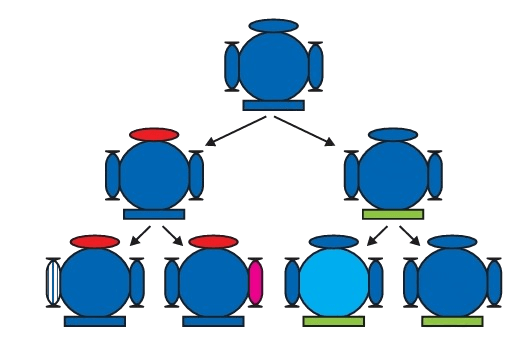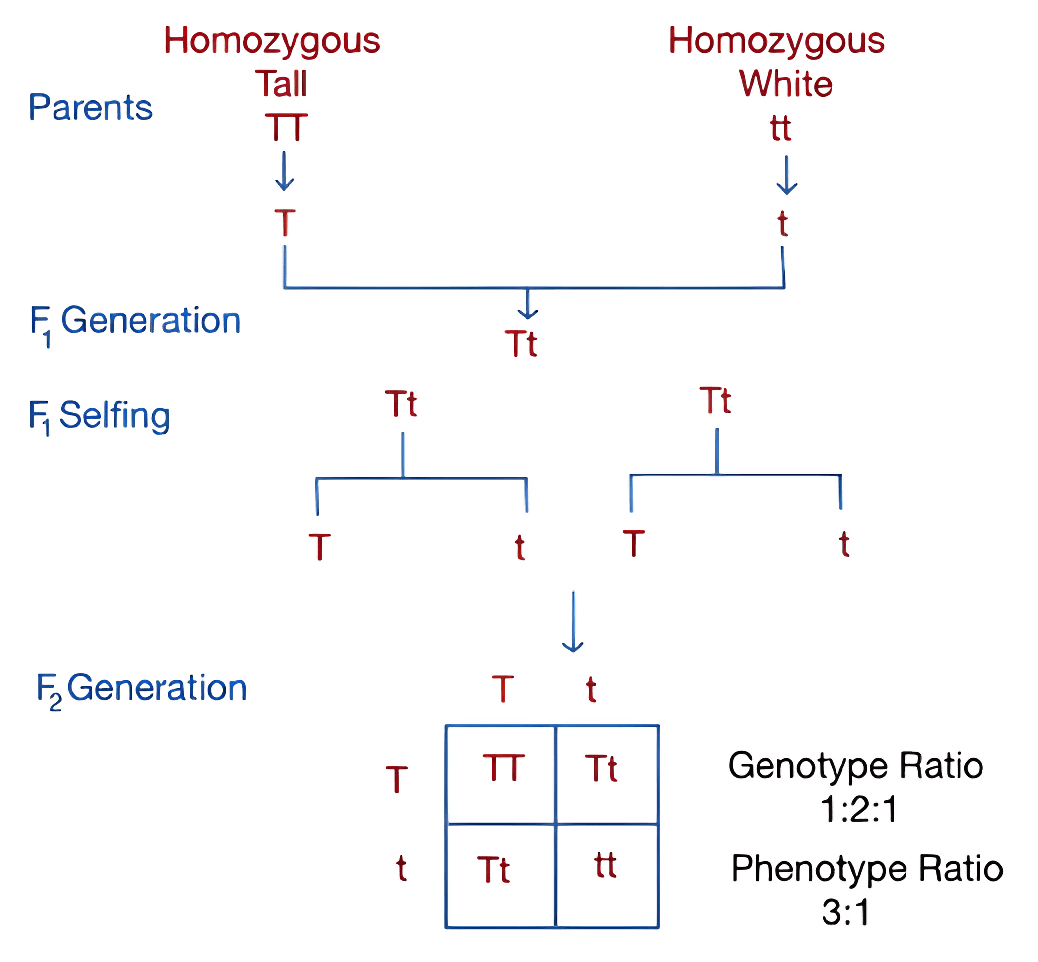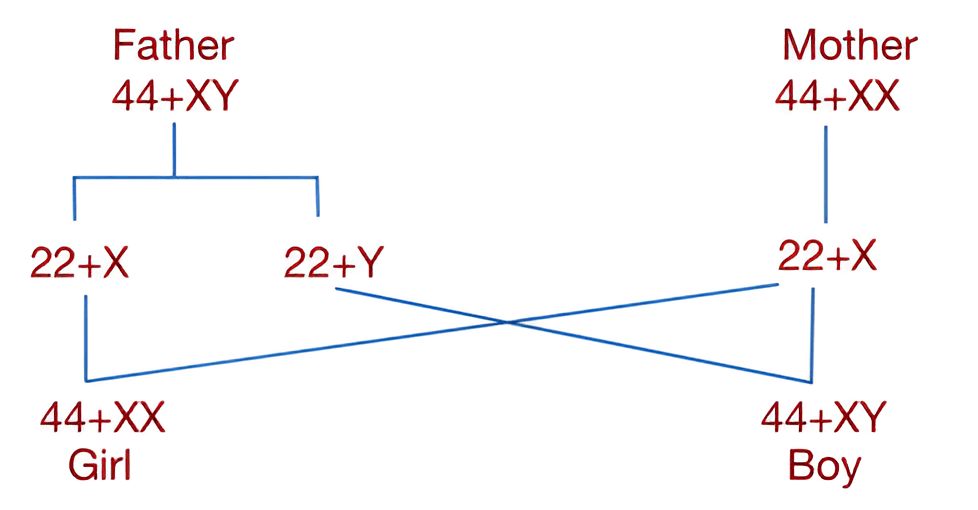Heredity
Heredity – Chapter 8 Class 10 Science (NCERT)
Heredity is Chapter 8 of Class 10 Science. This chapter helps students understand heredity, accumulation of variation, Inherited and acquired trait. Monohybrid and dihybrid cross, Law of inheritance (Heredity), how do trait get expressed and sex determination. Below are comprehensive notes aligned with NCERT, RBSE and CBSE board exam patterns.
Introduction
Reproduction is the process by which an organism produces new individuals of its own kind. During this process, characters are transferred from parents to offspring, so the offspring look similar to their parents.
Heredity: Heredity is the transfer of characters from parents to offspring or one generation to next.
Variation: Differences in characters among individuals of the same species.
- In asexual reproduction, variations are very minor and occur due to small inaccuracies during DNA copying.
- Sexually reproducing organisms show greater variation compared to asexually reproducing ones because two parents are involved, and the offspring inherit a mix of traits from both, leading to more variation.
Accumulation of Variation

When an organism reproduces, it passes on the basic body design along with subtle changes, known as variations. When this new generation reproduces, it passes on both the inherited variations and newly created ones. In this way, variations get accumulated over generations. Each new generation carries the variations of all previous generations along with its own newly developed variations.
Question: Write importance of variations.
Answer: (i) Variations helps organisms to adapt to the changing environment.
(ii) Helps in Evolution of species and formation of new species.
Traits its Types
- Any observable feature of an organism is known as Characters.
- Alternative forms of a characters are known as traits.
- Example: The shape of the earlobe is a character, while free and attached earlobes are its traits.
- A trait that can be passed from parents to offspring is known as an inherited trait.
- A trait that is acquired during the lifetime of an organism is known as an acquired trait. These traits are not passed from one generation to the next.
Rules for the Inheritance of Traits – Mendel’s Contribution
- In humans, each character is controlled by a gene.
- Genes are segments of DNA that control particular characters.
- An alternative form of a gene is known as an allele.
- In humans, both the father and the mother contribute approximately equal amounts of genetic material to the child.
- This means that each trait is influenced by two alleles—one from the father and one from the mother.
- So, what trait will be expressed in the child?
- Mendel discovered the fundamental rules of such inheritance and gave heredity law.
Gregor Johann Mendel (1822–1884)

Mendel was educated in a monastery. He later went to the University of Vienna to study science and mathematics. He worked on garden pea (Pisum sativum) for seven years. Although many others had studied inheritance before him, they did not succeed. Mendel, however, was successful because:
- He combined his knowledge of science and mathematics.
- He was the first to keep a detailed count of individuals showing specific traits in each generation.
7 Contrasting Trait of Pea
Contrasting traits are two opposite forms of the same character.
| # | Properties | Dominant | Recessive |
| 1 | Height | Tall | Dwarf |
| 2 | Colour of Seed | Yellow | Green |
| 3 | Shape of Seed | Round | Wrinkled |
| 4 | Colour of Pod | Green | Yellow |
| 5 | Shape of Pod | Inflated | Constricted |
| 6 | Colour of Flower | Violet | White |
| 7 | Position of Flower | Axial | Terminal |
Question: Why Mendel Choose pea plant for his heredity experiment.
Answer: Reason of selection of Pea Plant: Bisexual flower, short life span, large number of offspring in single cross, have many contrasting traits. All these properties made pea plant suitable for his heredity experiment.
Monohybrid Cross
Cross in which inheritance of one character is studied at a time is known as monohybrid cross. Example: Cross between a Homozygous tall and homozygous white.

Law Based on Monohybrid Cross
1. Law of Dominance: Each character is controlled by a pair of factors (allele). In a dissimilar pair of factors, or in a heterozygous condition, only one allele expresses its effect (called the dominant allele), while the other fails to express its effect (called the recessive allele).
2. Law of Segregation: During the gamete formation, the two factors (alleles) for a character separate and go into different gametes. This ensures that each gamete carries only one allele for each trait. It is also known as law of purity of gametes.
Dihybrid Cross
Cross in which inheritance of two character are studied at a time is known as dihybrid cross. Example: Cross between a Homozygous Yellow round seed and homozygous green wrinkled seed.

Law Based on Dihybrid Cross
3. Law of Independent Assortment: During inheritance of two characters, the inheritance of one character is not affected by the presence of other character.
How do these Traits get Expressed?
- Cellular DNA contains the information needed to make proteins.
- A gene is a segment of DNA that carries instructions to make a specific protein.
- Protein made from genes control various traits.
- Genes ⟶ Proteins ⟶ Traits
- Example:
- Tallness in plants is controlled by growth hormones.
- Hormone production depends on certain enzymes or proteins.
- A working gene makes an efficient enzyme ⟶ more hormone ⟶ Tall plant
- A faulty gene makes a less efficient enzyme ⟶ less hormone ⟶ Dwarf plant.
- In this way traits get expressed or gene controls trait.
Sex Determination
Sex determination is the phenomena of determination of sex or gender of an offspring. There are two modes of sex determination:
- Environmental Sex Determination: In this environment decide the gender of an offspring. Examples: In few reptiles, the temperature at which fertilized eggs are kept determines the gender of offspring. In Snails, individuals can change sex.
- Genetic or chromosomal Sex Determination: In this gender is determined by a pair of chromosome called sex chromosomes. Example: Human.
Chromosome
- Genes are present on chromosomes.
- Chromosomes are separate, independent pieces of DNA that carry genes.
- Each cell will have two copies of each chromosome.
- One copy from male and one from female parents.
- During the formation of germ cells/ gametes (sperm and egg), each germ cell receives only one chromosome from each pair. This means germ cells have half the number of chromosomes compared to body cells.
- When a sperm and egg combine during fertilization, the two sets of chromosomes come together, and the original number of chromosomes is restored in the progeny.
- This process ensures the stability of DNA of the species across generations.
Types of Chromosomes
- Chromosomes are of two types:
- Somatic Chromosome
- Sex Chromosome
- Humans have 46 chromosomes:
- 44 or 22 pairs Somatic Chromosome
- 2 Sex Chromosome (XX – Female, XY – Male).
Sex Determination in Human
- Sex of human is determined by genetic or chromosomal mechanism.
- Human has 46 chromosomes. Male has 44+XY chromosomes and female has 44+XX chromosomes.
- Male produces two types of gametes (sperm) one with 22+Y and other with 22+X. Female produce only one type of gamete (Ovum) with 22+X.
- In case ovum fertilize with a sperm having X chromosome then, the zdygote develops into female.
- In case ovum fertilize with a sperm having Y chromosome then, the zygote develops into male.

Conclusion of Sex Determination
- The sperm decides whether the baby will be a boy or a girl.
- There is an equal chance of having a male or female child.
Heredity Intext Questions NCERT
1. If a trait A exists in 10% of a population of an asexually reproducing species and a trait B exists in 60% of the same population, which trait is likely to have arisen earlier?
Answer: Trait B is likely to have arisen earlier because it is present in a larger percentage of the population. In asexual reproduction, traits spread slowly, so older traits are found in more individuals.
2. How does the creation of variations in a species promote survival?
Answer: The creation of variations in a species enables some organisms to adapt better to changing or harsh environmental conditions. These surviving members reproduce and form more such individuals. That’s how variations protect a species from extinction and increase survival.
3. How do Mendel’s experiments show that traits may be dominant or recessive?
Answer: Mendel performed a monohybrid cross between tall and dwarf pea plants. In the F1 generation, only the tall trait was expressed, while the dwarf trait was not visible. This showed that the tall trait is dominant, and the dwarf trait is recessive. Thus, the trait expressed in F1 is called dominant, and the one that is hidden is recessive.
4. How do Mendel’s experiments show that traits are inherited independently?
Answer: Mendel performed a dihybrid cross between pea plants, for example, crossing plants with yellow round seeds and green wrinkled seeds. In the F1 generation, all plants had yellow round seeds. In the F2 generation, he observed new combinations like yellow wrinkled and green round seeds. This showed that seed color and shape are inherited independently of each other.
5. A man with blood group A marries a woman with blood group O and their daughter has blood group O. Is this information enough to tell you which of the traits – blood group A or O – is dominant? Why or why not?
Answer: No, this information is not enough. Without knowing the exact genotypes of the parents, we cannot say which trait is dominant or recessive.
For example, a father with blood group A can have genotype AA or AO, and a mother with blood group O has genotype OO. Since their daughter has blood group O, the father must carry the O allele (AO). However, to confirm which trait is dominant, we need to observe the blood groups of all their children, because dominance is determined by how traits appear across many offspring, not just one.
7: How is the sex of the child determined in human beings?
Answer: In human beings, the sex of the child is determined by the combination of sex chromosomes inherited from the parents. Females have two X chromosomes (XX), while males have one X and one Y chromosome (XY). The mother always contributes an X chromosome through her egg, but the father can contribute either an X or a Y chromosome through his sperm. If the sperm carrying an X chromosome fertilizes the egg, the child will be female (XX). If the sperm carrying a Y chromosome fertilizes the egg, the child will be male (XY).
Heredity Chapter End Exercise
1. A Mendelian heredity experiment consisted of breeding tall pea plants bearing violet flowers with short pea plants bearing white flowers. The progeny all bore violet flowers, but almost half of them were short. This suggests that the genetic make-up of the tall parent can be depicted as
(a) TTWW
(b) TTww
(c) TtWW
(d) TtWw
Answer: TtWW.
2. A heredity study found that children with light-colored eyes are likely to have parents with light colored eyes. On this basis, can we say anything about whether the light eye color trait is dominant or recessive? Why or why not?
Answer: No, we cannot say if light eye color is dominant or recessive just from this information. We don’t know if the parents have two same or different genes for eye color. To find out if a trait is dominant or recessive, we need to study how it passes through many generations of a family. This helps us understand how the trait is inherited.
3. How is the equal genetic contribution of male and female parents ensured in the progeny?
Answer: Equal genetic contribution of male and female parents is ensured because both the egg from the mother and the sperm from the father carry the same number of chromosomes. Each parent provides 23 chromosomes, so together they form 46 chromosomes in the offspring. This way, the child inherits half of its genetic material from the mother and half from the father.
Heredity PYQs
Heredity RBSE PYQs
- Males have sex chromosomes
(a) XX
(b) XY
(c) XXX
(d) YY - Which of the following is correct option for the dominant traits.
(a) Tall and wrinkled seeds
(b) Short and round seeds
(c) Tall and round seeds
(d) Short and wrinkled seeds - In the experiment of Mendel’s law of inheritance of traits, the proportions/percentage of dwarf plants found in plants obtained in F2 progeny was _________.
- Draw a line diagram showing inheritance of traits up to F2 progeny between pure Tall (TT) and pure dwarf (tt) plants.
- In the experiment of Mendel’s law of inheritance, the proportion/percentage of tall plants obtained in F1 progeny was.
- Write the external features of the genotype of following seeds. (i) RRyy (ii) rrYY.
- What is the basis of sex-determination in human beings? Explain.
- If long plants of pea with round seeds are crossed with short plants with wrinkled seeds, which type of plants will be obtained in first and second generations? Write the phenotypic ratio of plants obtained in second generation (F2).
Heredity CBSE PYQs
- Assertion (A): The sex of a child in human beings is determined by the type of chromosome inherited from the father.
Reason (R): A child who inherits an ‘X’ chromosome from the father will be a girl (XX), while a child who inherits a ‘Y’ chromosome from the father will be a boy (XY).
Choose the correct option:
(a) Both (A) and (R) are true, and (R) is the correct explanation of (A).
(b) Both (A) and (R) are true, but (R) is not the correct explanation of (A).
(c) (A) is true, but (R) is false.
(d) (A) is false, but (R) is true. - Name the information source for making proteins in the cells.
- Define Heredity.
- (a) Why did Mendel carry out an experiment to study inheritance of two traits in garden pea?
(b) What were his findings with respect to inheritance of traits in F1 and F2 generation?
(c) State the ratio obtained in the F2 generation in the above-mentioned experiment. - A green stemmed rose plant denoted by GG and a brown stemmed rose plant denoted by gg are allowed to undergo a cross with each other.
(a) List your observations regarding:
(i) Color of stem in their F1 progeny
(ii) Percentage of brown stemmed plants in F2 progeny if plants are self-pollinated.
(iii) Ratio of GG and Gg in the F2 progeny.
(b) Based on the findings of this cross, what conclusion can be drawn? - With the help of a flow chart explain in brief how the sex of a newborn is genetically determined in human beings. Which of the two parents, the mother or the father, is responsible for determination of sex of a child?
- “It is possible that a trait is inherited but may not be expressed.” Give a suitable example to justify this statement.
Heredity – Practice Questions
- In human beings, the sex of a child is determined by:
(a) The mother’s chromosomes
(b) Environmental factors
(c) The father’s chromosomes
(d) Hormonal changes - What is the function of a gene?
(a) To produce hormones
(b) To store nutrients
(c) To provide information for protein synthesis
(d) To regulate blood flow - In a dihybrid cross involving seed shape and seed color, the F2 generation shows a 9:3:3:1 phenotypic ratio. What does this indicate about the inheritance of these traits?
(a) Traits are linked and inherited together
(b) Traits are independently assorted
(c) Only dominant traits are expressed
(d) Recessive traits are eliminated - Define Heredity.
Explore Our Quality Contents
All Class 10 Social Science Chapters
All Class 10 Science Chapters
Suggest Links
NCERT Official Text Books
Rajasthan Board Official Site
CBSE Official Site
